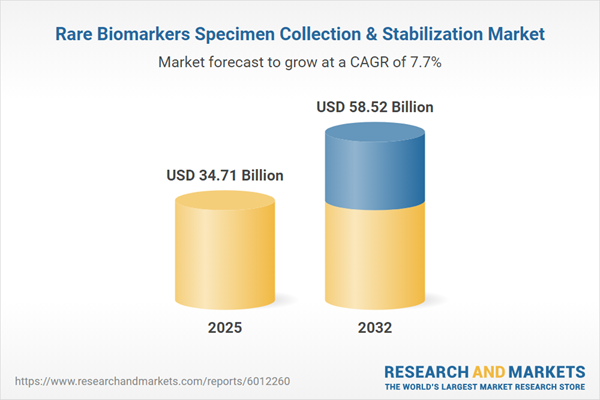Speak directly to the analyst to clarify any post sales queries you may have.
The Rare Biomarkers Specimen Collection & Stabilization Market is experiencing robust transformation, propelled by advancements that are reshaping specimen quality management for next-generation diagnostics. Senior decision-makers face an evolving landscape where workflow efficiencies and sample integrity are critical for translational success.
Market Snapshot: Rare Biomarkers Specimen Collection & Stabilization Market
The global rare biomarkers specimen collection and stabilization market is demonstrating strong momentum, with revenues rising steadily and a healthy CAGR projected over the forecast period. Growth is influenced by the expanding demand for precision diagnostics, technological developments in microfluidic platforms, improved reagent chemistries, increased automation, and supportive regulatory frameworks.
Scope & Segmentation
This report delivers a detailed analysis of the rare biomarkers specimen collection and stabilization market, including critical segmentation dimensions and geographic coverage:
- Product Offerings: Blood collection tubes, isolation kits and reagents, comprehensive workflow systems catering to both routine and advanced laboratory settings.
- Specimen Types: Circulating cell-free DNA (ccfDNA), circulating cell-free RNA (ccfRNA), circulating tumor cells (CTCs), exosomes, and extracellular vesicles, all requiring distinct preservation and handling methods.
- Stabilization Techniques: Chemical preservation solutions, lyophilization for extended ambient storage, and temperature control methods such as freezing and refrigeration tailored to specific analyte stability needs.
- Collection Methods: Automated platforms boosting throughput and reproducibility, alongside manual collection options allowing adaptability for specialized applications.
- Applications: Genetic testing workflows, infectious disease detection, neurology biomarker analysis, and oncology-related liquid biopsies.
- End Users: Contract research organizations (CROs), diagnostic centers, hospital laboratories, and research institutes, each presenting unique scale and innovation requirements.
- Regional Coverage: Comprehensive insights into Americas (North America, Latin America), Europe, Middle East & Africa (Europe, Middle East, Africa), and Asia-Pacific, accounting for infrastructure diversity, regulatory environments, and market accessibility.
- Companies Tracked: Sector-leading and emerging industry participants such as Thermo Fisher Scientific Inc., F. Hoffmann-La Roche Ltd., Danaher Corporation, Becton, Dickinson and Company, QIAGEN N.V., PreAnalytiX GmbH, Streck, Inc., Merck KGaA, Agilent Technologies, Inc., and Bio-Rad Laboratories, Inc.
Key Takeaways for Senior Decision-Makers
- Strong market growth is underpinned by innovation in collection devices and ambient-stable reagents, enabling better specimen preservation and more reliable analytic results.
- Integrated workflow solutions help bridge gaps between discovery and clinical adoption, which is essential for organizations seeking to maintain data integrity throughout specimen collection and analysis.
- Automation and digitalization in specimen management are enhancing throughput, traceability, and regulatory compliance, providing laboratories with scalable and repeatable solutions.
- Increasing collaboration among manufacturers, reagent providers, and academic stakeholders is producing validation frameworks that accelerate market adoption and enhance clinical reliability.
- Strategic supply chain adjustments, including local manufacturing and vendor diversification, are becoming more prominent as organizations navigate evolving international trade environments.
- Customizable solutions tailored to specific application and end-user requirements help address sample degradation risks and meet testing needs across genetics, oncology, infectious diseases, and neurology.
Tariff Impact: United States Focus
Recent tariff changes in the United States have prompted industry participants to reevaluate supply chains and sourcing strategies. Input cost increases for specialized reagents and advanced devices are driving a search for tariff-exempt suppliers, and some organizations are renegotiating procurement agreements to sustain cost efficiency. Meanwhile, domestic production efforts are expanding, reflecting demand for security of supply and market share capture in a more complex global environment.
Methodology & Data Sources
The analysis in this report is built upon a multi-source research methodology. Primary interviews with experts across academia, clinical labs, manufacturers, and suppliers provided deep insight. Rigorous secondary research, including literature reviews and regulatory guideline assessments, ensured a comprehensive and validated viewpoint. Consistency and accuracy are further enhanced through expert validation workshops, supporting robust strategic recommendations.
Why This Report Matters
- Empowers senior leaders with actionable intelligence to safeguard sample integrity, streamline operational workflows, and accelerate innovation pipelines in rare biomarker research and diagnostics.
- Delivers crucial insights for adapting to regulatory and supply chain challenges, supporting informed stakeholder decisions amid evolving market conditions.
- Guides investment and partnership priorities by profiling leading companies, technology trends, and regional growth opportunities in the rare biomarkers specimen collection and stabilization market.
Conclusion
Executives and research leaders who leverage this report’s intelligence will be positioned to enhance operational resilience, secure data quality, and identify scalable growth opportunities in rare biomarker specimen management.
Additional Product Information:
- Purchase of this report includes 1 year online access with quarterly updates.
- This report can be updated on request. Please contact our Customer Experience team using the Ask a Question widget on our website.
Table of Contents
3. Executive Summary
4. Market Overview
7. Cumulative Impact of Artificial Intelligence 2025
Companies Mentioned
The companies profiled in this Rare Biomarkers Specimen Collection & Stabilization market report include:- Thermo Fisher Scientific Inc.
- F. Hoffmann-La Roche Ltd.
- Danaher Corporation
- Becton, Dickinson and Company
- QIAGEN N.V.
- PreAnalytiX GmbH
- Streck, Inc.
- Merck KGaA
- Agilent Technologies, Inc.
- Bio-Rad Laboratories, Inc.
Table Information
| Report Attribute | Details |
|---|---|
| No. of Pages | 191 |
| Published | October 2025 |
| Forecast Period | 2025 - 2032 |
| Estimated Market Value ( USD | $ 34.71 Billion |
| Forecasted Market Value ( USD | $ 58.52 Billion |
| Compound Annual Growth Rate | 7.7% |
| Regions Covered | Global |
| No. of Companies Mentioned | 10 |









